Back to School! Back to School! Back to School!
SHOP & EATLOCAL

INSIDE: Sponsored in part by: Sponsored in part by:
SEPTEMBER CELEBRATES ASSISTED LIVING!












Back to School! Back to School! Back to School!
SHOP & EATLOCAL

INSIDE: Sponsored in part by: Sponsored in part by:
SEPTEMBER CELEBRATES ASSISTED LIVING!











Water plays a vital role of virtually all body functions for people and dogs alike. When your dog is losing more water and electrolytes than they are taking in, dehydration occurs and your pet's body will begin to suffer. Dehydration is so serious that it can lead to kidney failure, loss of consciousness, and in extreme cases, dehydration in dogs can be fatal.
It’s not rocket science, your dog, just like yourself, will naturally lose water throughout a scorching hot day by through panting, breathing, potty-ing and even evaporation through their paws. And if you don’t replenish those fluids and minerals, you could be in trouble.
If your pet's body reaches the point where intake is less than the amount their body is losing, their blood flow and the volume of fluids is reduced, which in turn reduces the delivery of oxygen to tissues and organs.
Electrolytes are naturally occurring minerals that humans and dogs need to keep their bodies healthy. Electrolytes include sodium, chloride, and potassium which help to balance the body’s pH, move nutrients into cells, facilitate muscle function, and regulating nerve function.
Have you ever heard the trick that if you pinch the skin on the top of your hand and it doesn’t snap back right away, you could be dehydrated? Well, that is the same with your pups!
If you pull lightly on your dog's skin and it doesn't readily go back to its original position, your dog is a bit dehydrated!
Xerostomia is another early sign of dehydration in dogs.
By emBARKXerostomia is when your pet's gums lose moistness and become dry and sticky, and your dog's saliva becomes thick and pasty.
Other symptoms of dehydration include: Loss of appetite, panting, dry nose.
Symptoms of severe dehydration include: Sunken eyes, collapse, shock.

If your dog is displaying symptoms of shock, heatstroke, or severe dehydration, call your veterinarian immediately or contact your nearest emergency animal hospital! Your vet may advise you to begin offering your dog small amounts of water to begin the rehydration process while you are on your way to their office. Treatment for dogs suffering from this level of dehydration is re-hydration using intravenous fluids.
If your pooch is mildly dehydrated provide your pet with small amounts of water to drink every few minutes or offer your dog pieces of ice to lick. To help restore your dog's electrolyte balance you could also provide your pup with Ringer's lactate (an electrolyte replacement fluid). Dogs typically require at least one ounce of water per day for each pound of body weight. If you're unsure whether your dog is drinking enough, ask your vet for advice on how to ensure your dog consumes enough fluids.
Do not offer too much water all at once since this could cause your dog to vomit, causing even further dehydration. Even if your dog is suffering from a mild cause of dehydration we recommend that you contact your vet for additional recommendations.
To prevent your healthy dog from developing dehydration, always provide your pet with an easily accessible and ample supply of clean drinking water. If your dog spends time outdoors in the hot weather or enjoys vigorous exercise, they will need extra amounts of water in order to stay hydrated.

When the temperatures rise, the hot weather can make your dog very uncomfortable, even lead to overheating and heatstroke.
Make sure your dog has access to fresh water and shade.

Early warnings your dog is overheating Tie a wet bandana around your dog's neck.


He acts sluggish or confused. His tongue appears bright red and he's panting hard.
If he appears to overheat, apply cool, wet cloths to his pads, belly & head.
Set up a fan so air circulates where your dog hangs out.
Never leave your dog alone inside a hot car, even with the windows open.
Set up a kiddie pool for your dog to splash around in.

Your dog's paws are not like shoes. Sidewalks and streets can become extremely hot, and paw pads can get burned by hot pavement.
Walk your dog on the grass during extreme heat to keep his paws cool.

Walk early in the morning or later in the evening when it's cooler out.
Be sure to avoid chemically treated lawns on your walk.
Source: puppypaws.info; akc.org



Two of the most wholly beneficial relaxation modalities are now combined into one and offered right here in the Chippewa Valley. Yomassage is as it sounds: yoga plus massage. Classes are for groups of two people at a time, fully clothed, and based on the principles of yoga–focus on breath and the yogic philosophy of looking within–with the added component of massage. Touch, gentle stretch and mindfulness together pave the way for relaxation and healing through the entire body, mind and soul.
Danielle Wagner, certified massage therapist and owner of Refined Touch Therapeutic Massage in downtown Eau Claire, completed her certification training for Yomassage and is now booking sessions. Wagner believes the power of massage is key in fostering and cultivating emotional, physical and spiritual well-being. She’s always on the lookout for new techniques that can bring the maximum benefit to a massage experience, and Yomassage was the perfect addition to her list of services.
By Becky Streeter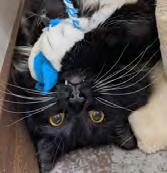

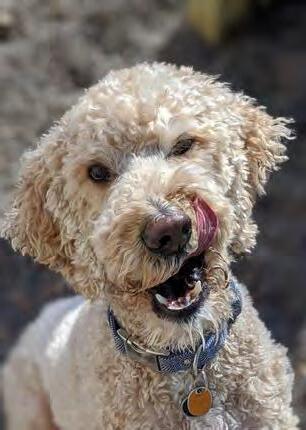

During a Yomassage class, you will be walked through a series of comfortable and supported positions held for 5-10 minutes. While relaxing in these positions, Wagner will guide you through breathwork and mindfulness exercises while walking around and massaging each participant as you hold the pose. You will leave having received a full body massage and feeling a “state of ultimate relaxation.”
Classes are designed for couples or groups of two so everyone receives the proper amount of attention from the massage therapist. The room is warm with gentle mood lighting and soft music. Everything is provided, so you just need to bring yourself, dressed in comfortable clothing. Yomassage is for all skill levels, no prior experience necessary.
To learn more about Yomassage, visit the official website at yomassage.com. To book a session with Danielle Wagner, call or text at 715-864-9596, or schedule online at refinedtouch.massagetherapy.com.
1. How can mindfulness be helpful with all that arises in late summer?

As the summer winds down to a close, many of us must shift from carefree days with little to no schedule (or a schedule that changes each week) to the organization of the school year. For some, this is a challenging transition. Our capacity to be present to our experience is critical, whether it is embracing school shopping or mourning the loss of casual, evening driveway gatherings with the neighbors. A regular mindfulness practice helps us cultivate that present-moment awareness so we don’t fast forward through the last days of summer to the business of the school year in our head.
2. What mindfulness tools can be used to address these experiences?
A daily practice of mindful breathing or mindful movement helps us cultivate awareness of our habits and patterns. For example, we notice when we are getting caught up in the to-do list in our head and not paying attention to the laughter of our children as watermelon juice runs down their chin, or the sounds of the band playing in the park. A regular practice helps us to show up to the moments of our life as they unfold.
3. Does the time of year come into play at all?
Each season has its unique joys and challenges. And it depends on the person to some extent. For me, the advent of a new school year is like New Year’s Day. I review my priorities, set goals, maybe even set some resolutions to be more organized, more productive, or eat healthier. I love the school year for the structure it provides to my daily life. But for others, the structure of the school year is confining rather than comforting. Mindfulness helps us to be more aware of our own unique habits and patterns, so we can respond skillfully to our experience.
Children are naturally mindful. They are in-tune with the full range of their experience-the movements of their body, the sounds they are hearing, their emotional experience. They are much less likely to get stuck in the story in their heads like us adults. We can take a page from their playbook and pay attention to what are we doing right now, whether that is feeling the sand between our toes or carefully sorting through last year’s school clothes to prepare for school shopping.
By Ann Brand, PhDMindfulness practice has many benefits. Because of advances in neuroscience, scientists can see how mindfulness practices work to change our brain and lead to benefits in physical health, stress reduction, attention, learning and memory, positive emotions, empathy, emotion regulation, and interpersonal relationships. Mindfulness practice can help us manage our stress and bring calm, clarity, and peace into our daily lives.
Mindfulness is a self-awareness practice. And when we get better at paying attention to our own experience, we get better at noticing others’ experiences. This is important as our family members begin to anticipate the beginning of another school year with its excitements and fears. When we listen and notice without judgement, we can respond to others more skillfully and support them in the best possible way. This paves the way for a smoother transition to the new school year.

Feeling overwhelmed, stressed, and exhausted by worries and responsibilities?
Looking for ways to bring more ease into the joys and challenges of life?

We can bring more awareness, clarity and calm to our lives with the practice of mindfulness.
Contact Ann to start the conversation.















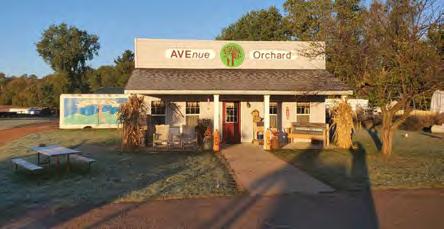









What Are Beneficial Insects? The average backyard is home to thousands of insects, and you may be surprised to learn that only about a tenth of these are destructive. Most are either beneficial or harmless. Beneficial insects fall into three main categories:
Pollinators: We depend on these insects—including bees, butterflies, flies, and moths—to pollinate our garden’s flowers. Predators: These insects eliminate pests by eating them. Parasitizers: They lay their eggs on or in the bad bugs, and when the eggs hatch, the larvae feed on the host insects.
Ladybugs Despite their delightful name and appearance, ladybugs are ferocious predators! Before they get their bright red colors, they start out life as larvae, cruising around on plants and feasting on aphids.

Green Lacewings Adult green lacewings feed on pollen and nectar, but their larvae prey upon soft-bodies garden pests, including caterpillars and aphids.

Praying Mantises Fierce predators will hunt many other insect pests, including moths, beetles, and flies. Note, however, that praying mantises are ruthless and will turn to eating other beneficials!

Spiders Very effective pest controllers. Since they are attracted to their prey by movement, they eat many live insects. Jumping spiders and wolf spiders are especially good at keeping pests under control.

Ground Beetles They will eat a wide range of insects, including nematodes, caterpillars, thrips, weevils, slugs, and silverfish. While insects like Japanese beetles should be controlled in the garden, be careful not to crush every beetle you see!

Soldier Beetles An important predator of Mexican bean beetles, Colorado potato beetles, caterpillars, and aphids. Like many beneficials, they are attracted to plants that have compound blossoms.

Assassin Bugs They use their sharp mouthparts to prey upon many different types of insect pests in the garden. In their adult form, they can be mistaken for squash bugs, so look carefully!

Robber Flies They may look intimidating, but unlike horseflies, they do not attack humans. Instead, they go after a number of common garden pests. Try not to shoo this fly!
Hoverflies They feed on pollen and nectar and are extremely important pollinators. Their larvae are voracious predators, killing aphids, caterpillars, beetles, and thrips by sucking the juice from their victims.
Parasitic Wasps Parasitic wasps are very tiny, so you will probably not see them at work. However, they are very effective, laying their eggs on the backs of and inside other insect pests.


Attracting Beneficial Insects: A diversity of plants will attract a wide range of insects.
• Early blooming plants, especially ones with tiny blossoms like alyssum, or biennials such as carrots or parsley that have been left to bloom will help draw beneficials to your yard in the spring.

• Later, they will be especially attracted to plants with compound blossoms such as yarrow, goldenrod, and Queen Anne’s lace and flowering herbs like lavender, mint, sage, dill, fennel, and lemon balm.
Remember that if you resort to using chemical pesticides to control insects, you will often kill good and bad bugs alike. Even the so-called “natural” pesticides like pyrethrum and rotenone will kill many beneficial insects.
Source: www.almanac.com/beneficial-insects-garden
5310 Freideck Rd, Eau Claire, WI 715.834.4332

www.tinroofgarden.com
Hours: Mon-Sat 8:30-5, Sun 10-4






since 1959. Our chiropractors have a combined experience of nearly 100 years of service to our community. At Stucky Chiropractic, we are committed to enhancing the health and well we have the o chemical stressors to the spine. This can result in the spinal vertebrae to becoming misaligned/ subluxated resulting in irritation and pressure on the nervous system. These mild to severe pain, loss of mobility and overall body dysfunction. Chiropractic care works to these subluxations to restore proper nerve flow to all the tissues of the body thus enhancing function. At Stucky and wellness goals.
Stucky Chiropractic Center has been helping the Chippewa Valley residents achieve greater health since 1959. Our chiropractors have a combined experience of nearly 100 years of service to our community. At Stucky Chiropractic, we are committed to enhancing the health and well-being of every person we have the opportunity to serve. We know that life’s events can cause physical, emotional, and chemical stressors to the spine. This can result in the spinal vertebrae to becoming misaligned/subluxated resulting in irritation and pressure on the nervous system. These areas of subluxation can cause mild to severe pain, loss of mobility, and overall body dysfunction. Chiropractic care works to correct these subluxations to restore proper nerve flow to all the tissues of the body thus enhancing optimal function. At Stucky Chiropractic, we offer a variety of services to help our patients achieve their health and wellness goals.
Our doctors are always evaluating new therapies that become available to improve the quality of lives. Just over a year ago we introduced to the Chippewa Valley a tissue regeneration therapy, as Softwave. This type of therapy is a healthy alternative, non-invasive approach to improving joint motion, decreasing pain and inflammation, and stimulating healing through the activation of your stem cells. Over the past year there have been many success stories reported through the use of conservative chiropractic techniques and specialized therapies like Softwave. One seventy-eight-year-old Veteran named Jerry stated, “Just this last year or so my shoulders have been really bad, very The pain was so bad I had to quit work. During one of my visits to Stucky Chiropractic the doctor about softwave therapy. Now that I understand how soft wave works, I would recommend it for They (Stucky Chiropractic Center) are the pioneers here in western Wisconsin only place you can get softwave!”
one of my visits to Stucky Chiropractic, the doctor told me about SoftWave therapy. Now that I understand how SoftWave works, I would recommend it for anyone! They (Stucky Chiropractic Center) are the pioneers here in western Wisconsin and the only place you can get SoftWave!”
SoftWave therapy is a highly effective treatment whereby high energy sound waves are applied to injured, degenerated and or painful areas of the body. The application of this therapy will result in reduced pain, increased mobility, and overall better function. This highly effective type of treatment has been shown to accelerate the healing process in the body by stimulating the metabolism and enhancing blood circulation and cellular repair to damaged tissue. The healing energy wave created by the SoftWave instrument penetrates tissues and stimulates the stem cells and the growth factors in the body that are responsible for muscle and connective tissue healing.
Softwave therapy is a highly effective treatment whereby high energy sound are applied to injured, degenerated and or painful areas of the body. The application of this therapy will result in reduced pain, increased mobility, and overall better
Our doctors are always evaluating new therapies that become available to improve the quality of people’s lives. Just over a year ago, we introduced a tissue regeneration therapy, known as SoftWave. This type of therapy is a healthy alternative, non-invasive approach to improving joint range of motion, decreasing pain and inflammation, and stimulating healing through the activation of your own stem cells. Over the past year, there have been many success stories reported through the use of conservative chiropractic techniques and specialized therapies like SoftWave. One seventy-eightyear-old Vietnam Veteran named Jerry stated, “Just this last year or so my shoulders have been really bad, very painful. The pain was so bad I had to quit work. During

If you or a loved one have been suffering needlessly with unwanted pain and disability, call the doctors at Stucky Chiropractic Center today to find out if SoftWave Therapy may be right for you.
This highly effective type of treatment has been shown to accelerate the healing in the body by stimulating the metabolism and enhancing blood circulation and repair to damaged tissue. The healing energy wave created by the softwave instrument penetrates tissues and stimulates the stem cells and the growth factors in the that are responsible for muscle and connective tissue healing.
If you or a loved one have been suffering needlessly with unwanted pain and disability, call the

Standing tall with balanced relaxed shoulders and proper hip position is not as simple and easy as it once was due our more sedentary lifestyle! Displaying good posture has positive effects on overall health and is an excellent barometer of how well your body systems can coordinate and stabilize all movements.
The twenty-four movable bones of the spine, stack from the hips/pelvis to the head, allowing for a graceful confident posture and a great amount of flexibility and adaptability. Stacked spinal bones protect delicate nerve structures which relay signals between brain and muscles and the complex systems of the entire body. All body systems require nerve signals for proper function which can be reflected in good posture, coordination, and balance. For over one hundred years, families have utilized the chiropractic approach to maintain proper posture and mobility for expression of health.
Early spine and nerve system stress can be observed in postural changes. Side-viewed, postural stress (such as forward head placement) is observed when the center of the earlobe falls too far forward in relation to the shoulders, which stack directly over hips. Forward head posture adds stress to the body, as does excessive forward hip stacking present in forward hip posture. Changes in posture reveal greater stress to the spine, nerves, and body systems, which can decrease the ability for stabilization and coordination and overall function of the entire body as a complex system.
Prolonged spinal stress leads to permanent changes such as ‘hunching or humping’ of the upper back and increased swaying, also known as ‘sway-back’ in lower back.

Proper rest, exercise, and diet are all essential to maintaining spinal posture. Occasional injuries to the body, however, can prevent optimal posture and movement. Sports injuries, such as sprains or strains, frequent slips and falls, auto accidents, and trauma alter spinal health. This increased stress on the nerve system, spine, and body systems further weakens upright posture, and affects overall wellness and mobility.
Postural spinal stabilization is essential for maintenance of muscles of the core, tone of the upper back, gluteal (buttocks) and hip muscles. Long term healthy mobility and balance require postural tone and coordination. Maintaining proper spinal posture over a lifetime helps to prevent headaches, arthritis, clicking of the shoulders, clicking jaw, fatigue, low back pain, clicking/pain of the hips, knee pain, instability, and risk of injury. Stress caused by poor posture is an important indicator of spine and nerve health and loss of coordinated nerve tone and muscle action. Chiropractic care utilizes gentle adjustments to correct injuries and restore body function over time, correcting spinal stress, and preventing prolonged spinal postural changes.
Observation of posture as a window to spine and nerve system function can reveal subtle, long-standing loss of coordination and stabilization. Specific chiropractic adjustments restore nerve system tone, enhancing communication between the brain and body, relieving persistent postural problems and restoring greater stability. Good posture is a welcome byproduct of maintaining spine and nerve system health.

My name is Dr. Drew Gintner and I own and operate Midwest Chiropractic Neurology in Chippewa Falls, WI. We often have patients ask what is chiropractic neurology? Are you a neurologist and a chiropractor? Not exactly. Functional Neurology or Chiropractic Neurology is a specialty that aids in diagnosing and rehabilitating simple and complex neurological conditions without pharmaceuticals or surgery. It also applies to athletes who want to perform at high levels and gain an edge on the competition or overcome injuries and return to play faster. To sum it up, this field is exercise for your brain that can benefit anyone.
Functional neurologists work with most neurological conditions as we are treating the individual and not their diseases. We cannot cure neurological diseases or change the ultimate outcome for someone with a degenerative condition. Our care is not designed to fix incurable conditions. Rather, our care is designed to improve function in the parts of the nervous system that still work to promote better function and a better quality of life for our patients. We do this through three different programs.
In our practice, we specialize in helping our patients connect the dots and create health-scapes that optimize all aspects of life so they can thrive. We offer our Stress Recovery Program, which includes gold-standard HPA axis testing and treatment. This program is designed to help patients with anxiety, depression, decreased mental clarity, lack of motivation, low libido, decreased energy, sluggish metabolism, hair loss, and difficulty sleeping. Another crucial foundation of health we address in our practice is leaky gut and metabolic syndrome.

Our GI Pillars Program is designed to seal up the gut and make it efficient again so your body can use fuel optimally. A porous and inefficient digestive system results from chronic stress, a lax lifestyle, and processed ingredients in foods. Another possible cause of leaky gut is head trauma or concussion. Put those two scenarios together and you can guarantee the gut is unhealthy. An unhealthy gut is a major source of inflammation resulting in pain, anxiety, brain fog, indigestion, gas, bloating, and if prolonged, auto-immune disease. Bottom line: if you have a leaky gut, you CAN’T be healthy.
When it comes to the immune system and auto-immune disease, our Immune Foundations Program is designed to help patients get their immune system back in check so their bodies can heal properly without damaging healthy cells and overreacting to triggers. We evaluate your individual situation and build a program that is unique to your needs so you can fight off whatever comes at you and build back stronger.
By Dr. Drew Gintner DCThese three programs—Stress Recovery, GI Pillars, and Immune Foundation—in conjunction with our brain-based chiropractic approach allow us to reboot the system and turn the ship to allow patients to perform at a higher standard.
I also have specialized training in acute and post-concussion evaluation and treatment. The before-mentioned programs are part of the puzzle in helping patients recover from head trauma and resume their daily lives. Without addressing the dysfunction in the HPA axis, gut, and immune system, concussion can be difficult to overcome and symptoms can linger. We utilize RightEye, which is a functional-vision tool that assesses different brain areas and how they are affected by the injury so targeted rehabilitation can begin as soon as possible. With concussion, the sooner treatment and rehabilitative exercise is implemented the more favorable the outcome. This is also a great tool for establishing a functional baseline before the sports season. That way, if an injury occurs, we have a comparison that goes beyond the impact test to ensure return to play is safe.
If you would like to schedule an appointment, please give us a call at 715-659-0636.


Breast Health Is in Your Hands, Tips for Breast Vitality and Sensuality is the title of a book recently published by Joyce Sobotta. Joyce’s passion for breast health ignited when conventional cancer treatments failed her sister, Theresa, who died from metastasized breast cancer. Joyce felt guided by her sister’s spirit to research holistic strategies for optimal breast health and put power into women’s hands, quite literally.
The book has nine chapters, including preserving healthy breasts, appreciating the lymphatic system, nutrition and digestion, the value of essential oils, understanding emotions, environment factors, integrated therapies, self-care and finding your sparkle.
An excerpt from the book: A congested lymphatic system may be the first area to check when there is unexplained pain in the breast. When the lymph is restricted with toxins of any kind, it can cause pain, infection, headache, fibrocystic breast, fibromyalgia, and other physical conditions.
Dr. Christiane Northrup states that drugs such as antidepressants, some statins, and some cardiac pills may have side effects for some women and may cause breast pain. Monthly cycles, pregnancy, lactation, or surgery may cause pain or discomfort. Surgical scars may cause pain and can develop pockets of swelling where fluid collects. The lymphatic breast self-massage may help to relieve inflammation and pain.
When there is too much estrogen in relationship to progesterone and other hormones, it causes an
 By Joyce Sobotta
By Joyce Sobotta
imbalance. Breast pain or hot flashes may be the symptoms. Pills with hormones, such as birth control or Hormone Replacement Therapy (HRT), have either estrogen or progesterone or both. They may not be exactly right for a particular woman, or she may react to additives or synthetics in the pill. A saliva test is recommended to obtain correct hormone levels.
Breast pain is NOT a risk for breast cancer. Dr. Christiane Northrup says the link between breast pain and breast cancer is very low, less than one percent! If you have breast pain, often simply breathing from the diaphragm will put more oxygen into all your cells and cause you to feel more relaxed and the pain is likely to disappear. Another cause for pain could be dehydrated cells crying for water.
Additionally, Digital Infrared Thermal Imaging (or Thermography) offers an opportunity of earlier detection of breast disease than is possible with selfexam, doctor exam, or mammography. As a non-invasive test of physiology, it can detect subtle physiologic changes that may be a cancer, fibrocystic tissue, an infection, or vascular disease. It is a pleasant experience to receive a scan with no squishing. It is especially appropriate for younger women who have denser breast tissue.
Taking time to be proactive and aware of changes in the breast is key. Performing a loving lymphatic breast selfmassage can move the lymph to clear out congestion, impurities/toxins and alleviate pain and tenderness.
The book can be purchased at www.joycesobotta.com, or from local stores: Mother Nature Foods, Tangled Up in Hue, and Volume One Store in EauClaire.
Joyce Sobotta is the founder of Healthy Girls® Breast Oil. She teaches the importance of the lymphatic system and how to use pure essential oils. Contact her for consultations and custom blends at www. AromatherapyNaturesWay.com.
We grow 20 acres of highbush blueberries in several varieties offered u-pick and prepicked. The season normally starts in early July. Prepicked apples and plums available.

Conveniently located 12 miles south of Eau Claire off Hwy 93 or 3 miles north of Eleva.

E2795 Hageness Road | Eleva | 715-287-3366
BlueberryRidge-Orchard.com
Are you a food entrepreneur who just needs to get your food out there so everyone can realize what they’ve been missing?

Or a caterer who needs space to create your products and services? Are you a farmer, looking to diversify your income with value-added products?

Bifrost Farms, previously a farmstead goat cheese creamery, has been converted into a licensed and inspected shared-use kitchen!















Alot has been going with our friends over at Together Farms in the past few months. Not only are they continuing to offer events with great food at their core, but they also have some exciting ongoing construction projects to help with expansion. With a goal of bringing people together, Together Farms is continually outdoing themselves.
The ever-popular weekly Burger Night is still in full force this time of year. Every week a new burger is announced on Wednesday or Thursday and available for the weekend. The name of the burger is decided upon as a team–they brainstorm, look at ones that had a positive response in the past (the Burger Named Goat was a huge success!), and play off of themes going on around town (like the Cowboy Burger around the time of Country Fest or Country Jam). You also can play themed trivia on Thursday nights, or enjoy live music on most Fridays and Saturdays. The staff and owners of Together Farms just really love bringing people together over
By Becky Streetergood food, and Burger Night truly makes this possible. Stephanie Schneider remarked, “Seems like everything in the world is currently trying to divide people, so being able to come together over food that is good for you, the animal, and the planet almost feels healing.”
Together Farms is offering a few additional events this year beyond Burger Night, too. Check out their website to see if there are still tickets available for any of the following sure-to-be-awesome outings (https:// togetherfarms.com/calendar):


• W ine Dinner on August 10th includes a multicourse, seasonal and farm-inspired meal paired with locally-sourced wine (or beer if requested).
• Comedy Night on August 17th with Devin Siebold. He’s a former teacher and draws from 13 years of experience in the schools to create his jokes and sketches, so this is a must-see for teachers heading back to school soon.

• Ramen pop-up event on Sunday, August 21st featuring their current Burger Night chef who is an expert when it comes to ramen.

• Beer Dinner on Wednesday, August 24th, with K-Point Brewery and Chef William from the Coffee Grounds who will be pairing great beer with great food.


Also, don’t miss the opening of their new farm store (hopefully this fall or early spring–fingers crossed!). Construction is fully underway for this much larger retail space. The old milkhouse they’re currently using is so small that many farm visitors don’t even know it’s there, and cannot accommodate the items Together Farms would like to showcase. Did YOU know Together Farms sells meat, and has been for almost ten years?! Hence, the need for a bigger store.
The larger retail space, however, is not just self-serving–there is a much grander plan for this building. “As our name suggests,” says Schneider, “we don't want to just try to grow our business bigger and try to do everything ourselves, we want to let the rising tide that is Burger Night lift all of the local growers and makers doing good work.” The staff at Together Farms has been in talks with over 30 other local businesses to start carrying their products when the new store space is ready. “We think that many of our restaurant guests and community will love being able to support other farmers and discover the amazing products we have right here in our backyards that many don't even know about!”
Another added benefit of the farm store is that the staff can consolidate some of their operations into one spot. Every week, when they receive online meat and product orders, they have to pack everything outside, running from the garage to the freezer to the house to the milkhouse and back again. It’s a bit of a fire drill and takes a good deal of time and energy. The new store puts all the business operations in the same space,
increasing efficiency, and creating at least one new staff position that will need to be filled. Schneider says, “The impact we'll be able to have on our agricultural and food systems will be fantastic–we'll be able to put local food security back in the local community where it should be. It's a big deal. I. Can. NOT. Wait!”
The staff at Together Farms realizes that inviting more people to visit the farm means they have to have space to accommodate all these people. Technically, because everything is outdoors, their capacity is limitless, so they’re taking advantage of that and creating a new lawn space. Eventually they’ll be able to add seating, but in the meantime it’s a great place for blankets and camping chairs. It will also be a nice flat area for throwing footballs and playing yard games, and for people to spread out and enjoy each other’s company (and maybe a burger and a beer).
With all the additions and opportunities to bring more and more people together, Schneider feels so grateful for everything and everyone who has brought them this far. She’d love nothing more than to share that gratitude with as many people as possible, and the construction projects don’t deter her one bit. Head down by Mondovi to check out the farm, feed your dinner leftovers to the pigs (for zero food waste!), hang out by the bonfire and be in good company.


“Come on out,” says Schneider, “watch the construction progress, and help us improve one burger at a time!”

Looking for a cup of coffee or tasty baked treat that will make you feel good about yourself inside and out? Head on over to the Eco Cafe at Wonders of Natures in downtown Eau Claire–it’s likely the most earth-friendly foodie experience you’ve had in a long time, if ever.


The Eco Cafe provides a calm, peaceful setting and a wide selection of truly fresh treats. Owner Chris Buske says the mission of the cafe is to “focus on wellness: using organic and sustainable standards wherever possible.” The items offered on their menu are free from GMOs, rbGH, palm oils, partially hydrogenated oils and corn syrups. When they can’t use organic, they make sure to use clean foods. Just like the mission for Wonders of Nature, Buske states, “We want people to know that when they come to us, they are getting quality products.”
The menu at the Eco Cafe is full of house-made treats, beverages and meals, offering vegan, vegetarian and gluten-free options as well. You can try a fresh baked muffin with your glass of juice right from the juicer. Or avocado toast with a glass of homemade Kombucha, for which they recently received licensure and are one of the only shops in town to make their own. If they can’t make it in house, the Eco Cafe sources from local partners, like coffee from Soul Brewed Coffee, honey from Bee Alchemy, and ham from Duetsch Family Farms. You can also ask to have any treat or beverage infused with a dose of CBD or THC from Wonders of Nature to continue that calming sense of well-being as you go throughout your day.
Part of the mission of the Eco Cafe is to be as sustainable as possible. Their goal is to reduce ALL waste material, including food and packaging. They send their animal-friendly food scraps out to Kubb Farm for animals to munch away on. Additionally, the Eco Cafe partners with Earthbound Environmental Solutions, LLC to compost any items that are not animal friendly. Earthbound has the capacity to compost hot enough to take care of the items backyard composters cannot. This includes the Eco Cafe’s biodegradable takeout containers, cups, lids, straws, napkins, and coffee grounds. All of this makes the Eco Cafe’s ‘zero waste out the door’ policy possible.
“This isn’t your typical cafe,” Buske states. “We want to turn people on to knowing that eating healthy can also taste really good.” So when you purchase a yummy brownie and a steaming cup of coffee from the Eco Cafe (perhaps infused with CBD or THC!), you are supporting local business, the earth, and your own health and wellness.







Eau Claire 4 Tomorrow is a 4 year old Kindergarten Early Learning Program offered to all four year olds in the Eau Claire Area School District.

* There is no charge for EC4T, however fees may apply for families participating in extended services beyond the EC4T program day.
How Do I Enroll?
If you child is 4 years old on or before September 1st, 2022, an Eau Claire Area School District enrollment form must be completed at: www.ecasd.us, click Enrollment at the top of the main page, click Early Learning Programs tab, click on the green
Kookies
Their decadently delectable graham-style Kookies are plant-based, organic and gluten-free with subtle hints of clover honey and maple sugar. marysgonecrackers.com

Strawberry Beet Lil' Puffs Berries. Beets. Geometric treats. Made from organic fruits and veggies, these tasty puffs are clean as can be – and not just because they won’t stain your whole home red! lesserevil.com
All of these great companies share the same philosophy that we do at Second Opinion by being organic, or mostly organic. Visit their websites to see all the other products they offer!


Parents, rejoice! You’ve found the perfect snack to feed your little Skouts. With 7 or less ingredients that you can pronounce, their Kids Bars are great for school, summer camp, and everything in between!
skoutorganic.com
7 Nut and Seed Butter
Delicious, nutritious blend of 7 nuts and seeds with no added oils or sugars! Upgrade your nut butter! Peanuts, cashews, almonds, hazelnuts, flax seeds, chia seeds, pumpkin seeds, brazil nuts, sunflower seeds, 70% dark Peruvian chocolate, and sea salt. nuttzo.com














When you’re a Girl Scout, you call the shots
Every Girl Scout has their own curiosity, dreams, and talents—so when they come together to decide which of the thousands of Girl Scout activities to try, the sky’s the limit. Whether visiting an animal shelter, camping, hosting a dance-off, or filming a movie—they’re learning to take risks, trust their gut, and team up with others for good.
Make friends
It's easy to make new friends as a Girl Scout. From joining a troop to spending a week at summer camp, Girl Scouts have the chance to meet others from their neighborhood, community, and nearby schools. They may even meet local leaders during a service project!


Have fun
A space to be yourself.
A squad that will cheer you on. A chance to try new things. That’s what being a Girl Scout is all about. Your Girl Scout community is a place to call your own, test your limits, and have a blast.
Find adventure
No adventure is too big for a Girl Scout. From discovering new museums to camping at a state park all weekend, there are as many ways to discover adventure as there are Girl Scouts. Go with a buddy or your entire troop and try something new.




Give back
Make an impact on your community. Restock the local food pantry. Beautify your school’s playground. Lobby for change at a city council meeting.
Making the world a better place is all in a day’s work for a Girl Scout. Take it to the next level when you earn the Girl Scout Bronze, Silver, or Gold Awards—our highest awards—to make a sustainable impact.
Lead your way
Girl Scouts have endless opportunities to lead.
Anyone can tell others what to do. A true leader can make smart decisions, act fairly and responsibly, and let others on the team shine as they work together. Whether it’s running their cookie business or directing a team of volunteers for a Gold Award project.
Learn new skills.
Then take those badge skills further with a Journey award or a Girl Scout Bronze, Silver, or Gold Award. A Journey award allows Girl Scouts to show they know how to take action and make a difference in their community. A highest award shows they know how to solve a problem, permanently.
The secret sauce holding it all together: joy

Forever-friendship is a powerful thing. It’s what gives Girl Scouts the confidence to be themselves, unapologetically. It’s what makes them feel safe enough to try new things and cheer each other on in tough times. It’s the support that can get them up on tough mornings, help them raise their hand in class, and even climb to the top of a mountain.
So if you’re looking for a place where you belong, somewhere you can make new friends, go on exciting adventures, and make a difference in the world—that place is Girl Scouts.

This fall Trinity Equestrian Center in Eau Claire is celebrating twenty years of business and service. Since the beginning, they have devoted themselves to connecting people, horses and God in everything they do, and it is evident in all aspects of their business. In the last twenty years, TEC has grown and flourished in so many ways. We caught up with owner Toni Mattson to hear all she had to say about her wonderful dream as it began, the course it has taken, and her hopes for the next chapter.
Q. What were your desires for Trinity when you first bought Pinewood Stables in 2002?
A. We were looking for a “home” for Kids Kamp, our multicity ministry. We brought kids in from Milwaukee, Chicago and Minneapolis to experience what happens when you connect people, horses and God. But at that time, we had no land or horses and we needed to impose on our generous friends who did have those things. After hosting a group from Milwaukee and seeing what God was doing, we knew (the future) Trinity was our calling. We originally looked for a small farm, with space for four horses, but God kept leading us to Pinewood Stables. Clearly He had way bigger plans for us than we did!
Q. You’ve offered so many services over the years, how have they evolved?
A. From boarding, lessons, horse camps, birthday parties, even daycare–you name it, we’ve probably done it. It’s been wonderful to meet so many families and kids and be part of their growth and learning. And the boarders we’ve had over the years have been a blessing. Eventually, though, it was time to settle into what we know is the highest and best use of our facility and our
our largest program, is headed up by our son and daughter in-law, Ian and Rachael Mattson. This program supports and inspires kids in creative and innovative ways. Ways that change their lives and futures.
Trinity’s Equine Assisted Therapy programs are where we team with our horses to provide hope and healing for survivors of trauma, trafficking, PTSD, emotional, physical and spiritual struggles. We work with individuals, families, and groups of ranging abilities and needs to help them learn new skills and gain the confidence to make the shifts needed.

A. I’d say there is one primary thing that causes me to be proud of many. When we were planning on leaving our hometown to find what we were called to be, my dad, a 20year Army veteran, gave me some legacy-building advice. He said, “When you choose a community as your home, you must become part of it, invest in it, and contribute to its members’ health and growth.” I believe for the past twenty years, with the programs and services we’ve provided, Trinity has done that in the Chippewa Valley.
We’ve stayed sensitive to the unmet needs of our region, and have designed and provided programs that meet those needs, often at no cost to the consumer. Whether it is for kids, families, veterans, or those with ranging needs, Trinity has and always will be on the lookout for ways to “contribute to our home’s health and growth.”
I’m also very proud of the work we do with Veterans. Our family has a long military history. Both Dad and Mom were WWII Army veterans, my husband (and Trinity co-owner) Bill is a USAF vet. Our brothers, cousins, uncles all served in the military. While Jan, (my sister and also Trinity coowner), and I are not veterans, we choose to honor our family’s military history by serving those who did serve, and struggle with their experience.
Since its inception in 2009, 750 veterans and their families have received over 7,000 free therapy sessions. In these two decades, we’ve watched the veteran suicide rate climb and stay at 22 deaths per day. We’ve created programs to help reduce the stress that contributes to that rate. We’ve provided computers, printers, and late model cars to veterans in need–for free. We’ve worked with Tomah VA to create specialty programs for veterans struggling with extreme trauma, and provided support programs for the partners and children of veterans, all at no cost. Most recently, we’ve taken our horses and therapy behind prison walls to serve male veteran inmates at Stanley Correctional Institution. And we are also
designing an initiative to address the skyrocketing rate of suicide among female veterans. We will always put our veterans first and serve them at no cost.
I’m proud of the size, scope, and the immense positive impact our Trinity Youth Mentoring program makes in the hundreds of mentoring sessions per month. What started with our son Ian mentoring one kid, grew into he and his wife Rachael managing an administrative team of thirteen, and eighty highly skilled, trained and certified Mentors. This program’s mission is to inspire, empower, challenge and grow this region’s kids into the best version of themselves no matter their varying range of backgrounds and needs.
I’m proud of the work we do for organizations seeking to fine tune their leadership and team building skills. It’s a privilege to help them see and make the changes needed for them to become even more effective teams that are
pebbles in the pond, making monumental ripples that reshape visions and futures.
I’m proud of the remarkable team of professionals we have the privilege of working with. They are truly chosen by God and have become family. They help us lean into challenges, do things differently, and expand our positive impact.
A. - To stay focused on our three pillars: mentoring, therapy, and training.
- To stay committed to doing whatever it takes to Change Lives.
- To continue being led by God and doing our very best work.
- To continue to “invest in our home (the Chippewa Valley) and contribute to its health and growth.”
October is Fair Trade Month and raises awareness about the importance of the fair trade movement to our global economy and promotes buying from businesses that are committed to fair trade in place of those which may harm the environment, the economy, communities, and disadvantaged individuals.

They're cultivating beauty, equality, and empowerment in West Africa. Alaffia aims to alleviate poverty and advance gender equality through the Certified Fair Trade of indigenous resources and community empowerment initiatives. www.alaffia.com
Sustainably grown and produced in West Africa with fair trade and unrefined shea butter and ethically sourced coconut oil. This delicate coconut shea butter whip is crafted with the most sensitive skin in mind.

Chebe powder is a unique commonly used North African ingredient, used for centuries to aid in hair growth and reducing shedding and breakage.


Made from a centuries-old recipe of handcrafted fair trade and unrefined shea butter and Orangutan-safe West African palm oil, and enhanced with eucalyptus and tea tree oils.


In Haiti and Morocco, they work with small-scale farmers to cultivate fair trade ingredients that help support growers, empower women, and develop deeper ties to the land and its communities. www.alaffia.com
Sleepy Body Lotion: A luxuriously rich lavender and tonka lotion to soothe your skin and mind before settling down for the night.
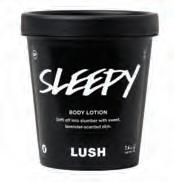
Dream Cream Body Lotion: Help is here for irritated, sensitive skin with this powerhouse packed with some of our most soothing ingredients like rose, lavender, and oat milk.
Pink Peppermint Foot Lotion: Minty peppermint and soothing arnica bring overworked feet back to life from heel to toe. Smooth some on and let it work its cooling magic.
Celestial Moisturizer: A gentle, light and soothing face cream for sensitive, dry skin with nourishing, calming ingredients like almond oil, dove orchid extract and cocoa butter.

Health care is as old as creation itself, and every culture has its traditional care practitioners and tools. Do you know that you have the right to choose who is on your team when it comes to health and wellness? We are incredibly fortunate to have access to a variety of conventional and alternative modalities if we know what care options are available and where to find someone who is an expert in their craft.
For so many of us, the very thought of cancer strikes fear to our core. Could that be because our understanding of the condition and options available to us is limited? In no way do I mean to minimize the shock and uncertainty that comes with a cancer diagnosis, but I offer to you the suggestion of taking back the power of fear of cancer and replacing it with a more powerful offensive team built around a well-informed understanding and attitude of hope.
I recommend looking at health care holistically and proactively, building a team of specialists, therapies and tools to help monitor and maintain health and vitality. Positive attitude, regular exercise, healthy diet and restorative rest are all important factors which affect one’s mind, body and spirit at every age.
This journal, Second Opinion, is a tool which supports being well-informed about options for care, including healthy recipes, mindfulness practices, physical activities and community. The publication is already part of your offensive strategy, otherwise you would dismiss it. I am honored to be part of this community, and in this installment, I will discuss including the tool of thermography in your offensive team equipment bag.
Thermography is a non-invasive, non-contact, painand radiation-free screening. A specialized digital infrared camera is used to take images of a particular region of interest of the body or of the whole body.
Thermography measures the temperature of the heat emanated from within the body through the surface of the skin. It detects changes in physiology, or function, such as inflammation, vascular change, lymphatic change and hormonal change. Thermography is ideal for monitoring these physiological changes and for watching the progress of healing with therapy.

Consider thermography to be an adjunct to other accepted methods of monitoring one’s health, including mammograms, physical exam and self-exam, and other evaluative procedures. It is not a diagnostic test and does not detect or diagnose cancer. It does not detect structure, such as that of a tumor, lumps, densities or calcifications, like an x-ray can view. In some cases, other conventional medical screenings are more appropriate to obtain the information needed. Keep in mind, none of the tests, including thermography, are considered as “stand-alone” tests and are always combined with other screenings. Combining multiple modalities and screenings is rather like assembling the various pieces of equipment players need for the game.
Thermography of Wisconsin serves patients at the main office in Eau Claire, WI, in River Falls, WI, and Park Rapids and Northfield, MN. Ms. Seuferer is a Certified Clinical Thermographer and a member of the American College of Clinical Thermology (ACCT). Bring a copy of this article with you to your next appointment and receive $25 off the regular price of your screening.

• Yes, You Can Live Well with Dementia
• Medicare Information Overload! What Does it All Mean?
• Signs It’s Time to Consider Memory Care for Your Loved One With Dementia

• Overlooked?
• Choosing the Perfect Monument
• The Life of a Funeral Director
• Not Quite Ready Yet?

SPONSORED IN PART BY


It has been ten years since my mom passed away from vascular dementia. We would have been more prepared for what was ahead if only I knew what I know now. Mom received her diagnosis four years prior, and the hope of living well with dementia was missing from our discussions. Days were often filled with doom, gloom, and fear as we waited and watched her health decline.
Several years ago, my dad began exhibiting early signs of mild cognitive impairment. He took a memory test willingly and then embraced an approach to life with dementia different from my mom because of his underlying health conditions.
My mom had risk factors - diabetes, obesity, HTN, and high cholesterol. My dad has a slight elevation in blood pressure and is approaching the pre-diabetic stages due to diet choices. He stays active to delay the effects of dementia in his life. The pandemic put limits on his favorite socialization activities in the community. Despite those challenges, he is a living example to me that you can live well with dementia—yes, you can.
A diagnosis of dementia is less likely to be revealed than a cancer diagnosis. People who learn of their diagnosis early in the stages of dementia are fortunate. The lack of early knowledge leaves many unaware of the options available to them and their loved ones. While an early diagnosis of Alzheimer's or related dementia may be scary to hear, think of it as your opportunity to live well with the disease.
Knowing early on allows you:
• Time to write down your wishes and plan for future care needs.
• Plan and talk with your physician about your concerns.

• To learn more about the disease and your risk factors.
• To learn about diet and the risks an unhealthy standard American diet has on your brain function.
• To learn how regular exercise helps your brain.
• To learn about vitamin deficiencies from the side effects of medications.
• To learn about your baseline memory skill measurements so you can monitor the effects of your lifestyle changes for the better.
• To learn about ways to cope with the changes.
• To find ways to continue enjoying activities.
• To learn about resources available to you.
In addition to support groups, keeping your brain active is one way to slow the progression of the disease. It's wise to seek out socialization activities free from awkwardness and stigma to help you live well and enjoy life.

A Memory Café is a place to connect with others in a safe, comfortable, and engaging environment. Guests laugh, learn, and remain socially engaged with others traveling the same journey. The activities vary based on the participants' interests. Individuals worried about memory loss or who have Mild Cognitive Impairment, those with early to moderate Alzheimer’s or related types of dementia, along with their family members or care partners are welcome to attend.
Contact your local Aging and Disability Resource Center (ADRC) for more information and the availability of Memory Café in your area.
Skilled Nursing/Personal & Supportive/Companionship
Live your life in your own home


Phone calls, TV ads, and random mailings informing you of special offers. Sound familiar? If you are a Medicare beneficiary, you probably know all too well. The bottom line: be careful!
While the focus of unwanted and misleading offers is often conducted by telephone, there are two other solicitation tactics to be aware of: television commercials and postcards/ mailings about Medicare plans. Though not necessarily fraudulent, they can be confusing and potentially cause issues with your providers, coverage, and prescription drugs.
Proceed with caution and know that if something sounds too good to be true, it probably is!
Have you seen the celebrity television commercials, encouraging you to call today to put money back in your pocket? Be careful. While more money sounds great, there is more to it than that. Eligibility criteria is not fully explained, and the plan may not be available in your area or may require you to change health care providers. Another word of warning: if you decide to call the toll-free number that is advertised, beware that you will be talking with an insurance agent, not directly with Medicare. The fine print states that this advertisement is not affiliated or endorsed by any governmental agency or Federal Medicare programs, plan availability varies by region or state. If you call, you are giving this insurance company permission to contact you and, in some cases, pressure
you in to deciding about a Medicare plan without understanding it completely. This can have a negative impact on your health care as well as your pocket.
The postcards/mailers notifying you that you may be entitled to a new Medicare plan with additional benefits…again, be careful! While the mailers say the right things and promise to add money back to your monthly Social Security payments, there is often a catch. The mailers are advertisements for insurance and are not connected to or endorsed by any governmental agency, including Medicare. Calling the number provided could mean more calls from persistent insurance agents.
Medicare is complicated and tv commercials, mailings, and phone calls can make it more confusing. But finally, some good news! There are resources available that provide unbiased information at no charge.
• Benefit Specialists at local Aging and Disability Resource Centers (ADRCs) and aging units in every county and tribe offer benefits counseling. For contact information, visit https://www.dhs.wisconsin.gov/ benefit-specialists/index.htm or call 608-266-2536.

• Medigap Helpline (800-242-1060): toll-free helpline operated by the Wisconsin Board on Aging and Long-Term Care; provides counseling for Medicare beneficiaries on Medicare, Medicare supplement insurance, employer-based health insurance, Medicare Advantage plans, long term care insurance and related topics.

• Wisconsin Medigap Part D and Prescription Drug Helpline (855-677-2783): toll-free helpline; answers questions from Wisconsin residents age 60+ about Medicare Part D and other prescription drug coverage options.
• Wisconsin Senior Medicare Patrol (888-818-2611): toll-free helpline for Medicare beneficiaries and their families to call to report suspected Medicare fraud, errors, and abuse.
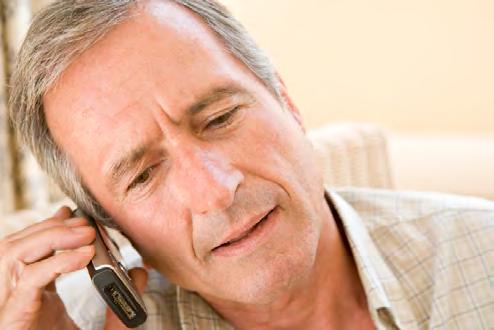

When elderly adults are having difficulty performing day-to-day activities or don’t feel comfortable in their own home, considering a care facility could be the perfect solution.
Memory Care homes provide all their residents with the extra attention and have the expertise to handle all levels of dementia residents.
It can sometimes be hard to know when your loved one needs more specialized care due to a dementia diagnosis. The amount of care varies depending on the level of dementia that person has. There are some general signs to look for when making the decision to move from home care or an assisted living home to a memory care home.

Some general signs to look for can include:

Your loved one might start becoming disoriented or unfamiliar with their surroundings. This leads to wandering which can be dangerous for an elderly adult due to them potentially getting lost or putting their safety at risk. Studies show that 60% of dementia patients wander and become disoriented.
Your loved one could start displaying different behavior, such as depression or frustration. This is a common change with the early stages of dementia. Moving your loved one to a memory care home can be beneficial to their mental and emotional well-being. Studies show memory care treatment can improve behavior problems after just six months of care.

You may find it hard to have a conversation with your loved one. This is most likely due to the declining of cognitive function. Dementia affects memory and communication functions, which makes it difficult to maintain social contacts and participate in traditional social activities.
Increased care needs
Dementia residents are in need of more care to help them
both mentally and physically. They may become extremely dependent on their caregivers for simple daily tasks. This ultimately can cause stress and burnout of other family members due to extra demands of the patient.

Seeking memory care for your loved one who is diagnosed with dementia can be difficult, but safety should come first when it comes to your loved one. Moving them into a specialized memory care home is the next step in your loved one’s life.
For more information about CarePartner Assisted Living and Memory Care Facilities, go to www.carepartnerscountryterrace.com


Our staff is here to guide and assist you with a high degree of respect and concern during your time of loss. We will provide the most fitting service for your individual needs, at the most affordable cost with the many options that we offer.
Two options to serve you, at one convenient location:
Flexibility is an often-omitted element in the search for the right assisted living location. Choosing a place to live is important – especially as we age. While there are many things to consider as we cross off the checklist of opportunities (things like location, amenities, meal plans, square-footage, privacy, care providers, activities, etc…), we might be overlooking one of the most critical elements of senior living. Flexibility!
Chippewa Manor, which is conveniently located just minutes from the heart of both Eau Claire and Chippewa Falls, provides the unique ability to flex on and off assisted living services on a monthly basis. It provides a tiered approached that not only personalizes the volume and types of care provided – it offers value in that you only pay for assisted living when and how you need it. You choose the amount of care – as little or as much as you need each month. There is no penalty or stigma for status change, and you have the flexibility to go on or off the Living Services program as needed. Nursing staff (comprised of state certified or licensed care providers) discretely provide assistance in the privacy of your own apartment on your schedule. Care is available 24-hours a day, 365-days a year.
But that’s not the only flexibility Chippewa Manor offers. Since its campus provides independent apartments, assisted living, rehab and skilled nursing, a move to Chippewa Manor means you won’t have to deal with the hassles and inconveniences of moving to another location as your needs evolve. You can access inpatient or outpatient therapy if needed, and if you require more supervised care, you will already be familiar with the people, environments and care options provided on campus. The campus also offers Rehab Suites, a shortterm option (living in an independent apartment on campus), for those who are completing therapy, but need a little more time before they are ready to return home safely.
“We see flexibility as a big factor in the emotional and physical well-being of those we serve,” said Jill Gengler, Chippewa Manor Campus President. “Experiences shouldn’t just be one-sided. We want them to be personalized and adaptable to the needs of those living with us.”

Chippewa Manor doesn’t push a one-size fits all approach to dining, living spaces or activity. You choose your apartment size (1-and 2-bedroom layouts are available). There is no sharing of bathrooms, kitchens or storage spaces with other residents. You choose if and what meals you would like to have delivered to your apartment or served restaurant-style in the dining room. You also have the flexibility to participate in as little or as many activities (including oncampus chapel services) as you would like – it’s all based on your individual preference.
“Our goals are really to create opportunities that meet people’s specific and unique needs,” Gengler said. “If or when you need assistance, we will be there to meet those needs. When you don’t, we provide you with the flexibility to live independently with peace of mind, knowing we are available 24-hours a day.”
And that’s what Chippewa Manor sees as the key to finding the right senior living experience: provide the flexibility and care levels you need and the preferences you want.
With the housing market and interest rates providing historic values for sellers, it might be the right time to consider making that move to a senior living opportunity with real flexibility.
For more information about senior apartments or assisted living services at Chippewa Manor call (715) 723-4437 or visit www.chippewamanor.com today.

Monuments are a great way to commemorate a life, and they should be chosen with care. Purchasing a monument is an investment of time and money, and it is your opportunity to express lasting sentiments for your loved one. With a wide variety of sizes and styles, the staff at Johnson Monument can help you create a beautiful memorial for generations to come.
Johnson Monument is a trusted family-owned and operated business open since 1917. When you meet with the Johnson Monument staff, they will ask a series of questions to make sure you are getting exactly what you want:
• What cemetery will the monument be in?
• How many people on the memorial?
• How many grave spaces?

• Is there something you want to match from another family member?
• Are there any memorials you have seen that you like?

• Is there a color that you like?
Though most meetings with customers are located at their showroom in Chippewa Falls, they also provide an at-home consultation service where they bring sample tiles as well as a photo album of other memorials they previously created.
Johnson Monument uses high-quality domestic or international granite, precisely cut and made to last. With over 1000 in stock, they have the largest inventory of memorials and monuments in West Central Wisconsin. You can choose from markers, upright monuments, benches, specialty monuments, and cremation memorials. Johnson Monument will sandblast your chosen lettering or design using a pre-cut stencil. They also have an artist onsite who can use a diamond-tipped etching tool for creating scenes or portraits, providing a personal touch.
Every cemetery has their own set of rules and regulations regarding the types of memorials they allow. Johnson Monument installs throughout Wisconsin and can also ship to other states, and they can help you select a memorial that complies with the rules of the cemetery where the monument will be installed. Some cemeteries charge a fee to locate the grave for placement of the memorial, or for pouring the cement foundation, so it is also a good idea to check with the cemetery staff about this as well.
Once everything is decided for the memorial, the order moves into their on-site production plant. Depending on the time of year and the type of memorial it may take 3-9 months for delivery. Then the staff from Johnson Monument will set the foundation in the cemetery, ensure that everything is level, and then complete the installation process themselves. They also provide a warranty for the foundation as well as for the memorial. Johnson Monument personally takes care of everything from beginning to end.
There’s no right or wrong time to pick a memorial. Some families are able to decide right after the loved one’s passing, and others need some time. Additionally more and more people are planning ahead and choosing their own memorials. There are many benefits to doing so:
• You can make it what you want by selecting the size, style and color.
• You can personalize it to reflect what is meaningful to you.
• You can save money. Like everything else, it will cost less now than in years to come.
• You can save your family the stress of choosing a memorial during their time of grieving.
Johnson Monument is here to help ease and simplify the creation of a monument to celebrate your loved one. For more information, visit their website www. johnsonmonument.com or call 715-723-5576 to set up a free consultation.
11.3 million seniors live alone in their homes
Some major concerns among families with seniors living at home are malnutrition & missing meds. A recent study shows loneliness increases the odds of dementia by
Cooking healthy meals consistently is a major issue for those 64%
For those 65+ falls are the most common reason for hospital trauma admissions and cause of injuries resulting in death.

It can be difficult to take care of elderly parents & juggle other parts of life.

55% 1 in 3 OVER 65
of seniors living at home alone said they felt too afraid to walk outside at night. adults over 65 fall each year
Recreational Activities Support Healthy Living Daily Task Help Assisted living offers easy access to nutritious food and can help with daily living tasks like medication management.
94%
Social interaction, activities, and hobbies are significant factors in a person’s quality of life of assisted living residents say they are happy with their overall quality of life
90% 93%
Assisted Living communities provide support w/daily living tasks. of assisted living residents say they are satisified with overall quality of care of assisted living residents say they are satisified w/the level of personal attention paid by staff
Family’s Peace of Mind Assisted Living communities provide safety of assisted living residents report feeling completely safe. 99%


The lifestyle of a Funeral Director/Embalmer is very different from other professions. We are called to work long hours when on-call. We respond to families 24 hours a day, 365 days a year. We may sit down with a family, totally exhausted, but we still need to be compassionate and pretend we are fine, and that causes a lot of personal stress. We want the public to understand that we are human beings, and we are assisting multiple families at one time. Sometimes mistakes happen and we are often judged harshly, as though we are expected be super human.

To add to the stress of the job, we are dealing with all kinds of family dysfunction in this day and age. We deal with family members’ anger towards each other
and their deceased loved one. Often, this gets taken out on us. It is very common for families to be estranged from one another, or spread out all over the country with little communication. These things can present numerous extra challenges when working with a family in their time of need.
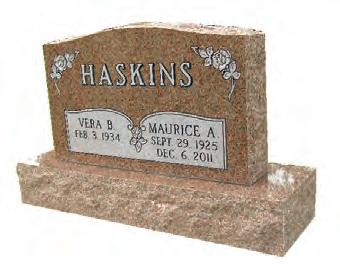

Throughout our careers, many times we have to put our own families last. We work nights, weekends, and holidays. We can be called away at a moment’s notice. It doesn’t matter if we’re at a wedding or our own child’s birthday party. Many of our children don't follow us into this field because of the sacrifices they have watched us make. Not only do we absorb the disappointment of our families, but oftentimes also the grief of the families we serve. It is very difficult

to compartmentalize so many feelings, and still present ourselves in a way that the public expects of us. This not only causes stress, but also anxiety and depression in our profession.

Just like many professions of late, we are experiencing a shortage of funeral directors. The need is approximately 1,400 new funeral directors per year to replace those leaving the workforce. There are only approximately 700 students coming out of the mortuary colleges, and to make matters worse, a third of those leave the profession within three years.
In our state, the education to become a Funeral Director is an Associate Degree in Applied Science, a year of apprenticeship, and a national board test. Many years ago, the licenses for Funeral Director and Embalmer were separate, but have since become combined. The problem with this is that not everyone is cut out to be both. Embalming requires a very specific skill set and is very technical, even scientific. A Funeral Director on the other hand must be very compassionate, a “people-person,” and a chameleon to be able to adapt to many different situations. We have to be able to sense the unspoken need. Finding a person who can be both is rare. The shortage in this field makes it impossible for the ones left doing it to be everything to everyone.
There are so many rewarding experiences, though, that make this career worth it. Our personal gratification when we connect with the family is almost unbelievable. Their gratitude can last for decades. After 50 years in funeral service, I've had countless families thank me long after their loss for what we did for them. “Our loved one looked so lifelike.” “The look of pain was gone.” “They looked so at peace.” “Every little detail was taken care of and your advice was spot-on.” “Thank you for being so caring.”
Death is the hardest thing anyone deals with. It is our job to be there for the family, educate them, and comfort them the best that we can, while trying to be there for our own loved ones and juggle the everyday things that life throws at us. We just ask for a little understanding and compassion as our industry works through the struggles we face.

The word “yet” has so many possibilities attached to it. It can hold promises and opportunities, or it can mean to put off what needs to be done. Many times, when discussing Aging in Place with people, I hear the response, “I know we need to do this, but we are not quite there yet.” However, the “yet” that we’re waiting for can come sooner than we expect.
There can be feelings of uncertainty as we start to think about what needs to be done, and sometimes it can be unsettling. No one likes to think about getting older and not being able to do things like we used to, though by not making some preparations, there can be unnecessary feelings of stress, confusion, and frustration. “Yet” does hold possibilities and opportunities that we can make the changes in our lives to help us live better now and into the future.
A good place to start is by thinking about how and where you want to live in the future. Do you want to move closer to family? Find a smaller house? Move to an apartment or condo? Or do you want to stay in your own home? Once these decisions are made, you can start taking the steps needed to prepare for your “yet.”
One of the first steps is decluttering the home. You’d be surprised at how much accumulates throughout life! Some ways to go about this is to share mementos with family and friends, have a garage sale, or hiring a company to help with the decluttering process. Having less in the home makes transitions easier whether that’s moving to an assisted living, or simply making a few accessibility changes in your current house.
For those that decide to stay in their own home and age in place, making it as safe and accessible as possible should be thought about as early as possible. By walking around the home thinking of how furniture and items in each room are used, is there anything that might be difficult to use or that could make someone unbalanced or unsteady? Assess the floors throughout the home to check for slippery or uneven surfaces. Carpets should be wrinkle free and rugs eliminated or secured with grips to the floor. For any steps or stairs in the home,
be sure there are hand holds or railings available that are properly anchored in the wall. Thresholds are a potential safety concern, with possible height changes or a bump up, these tripping hazards can be harder to address. To improve thresholds, make sure they are visible by changing the color or by adding a threshold ramp.
An additional step to make the home safer is to schedule an Aging in Place Home Assessment. This can be a great way to gather information on new technology, equipment, and services that could possibly help limit home modifications. By doing an assessment and receiving a complete plan, vast possibilities are available to you for the home to be ready when your “yet” comes.
• Colonial style home -built in 1991

• Offering 4 spacious resident rooms, with each room featuring 249 square feet of living space, a private bath, and a gas fireplace
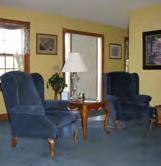



• Focus is individualized assisted living for adults who can benefit from personal care, health monitoring, and supportive services to improve, stabilize, or maintain their physical health, mental health and well-being.









